 Hello science and science fiction fans! We went on another wild ride “Through the Wormhole” with Morgan Freeman on Wednesday night. I have had company so I am a few episodes behind, but I will catch up! The episode “The Riddle of Black Holes” was a theoretical ride into the very heart of a black hole!
Hello science and science fiction fans! We went on another wild ride “Through the Wormhole” with Morgan Freeman on Wednesday night. I have had company so I am a few episodes behind, but I will catch up! The episode “The Riddle of Black Holes” was a theoretical ride into the very heart of a black hole!
In the first episode Freeman asked the question “Is there a creator”, and he gave us three very thought provoking answers. In this week’s episode he did the same thing. It would appear that Freeman intends to leave us each week scratching our heads and asking questions to further our understanding of th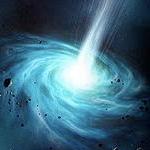 e topic.
e topic.
Just what is a black hole? Freeman tells us that “astrophysicists think that black holes might form when giant stars run out of fuel and collapse under their weight.” He then goes on to say that we do not know what a black hole really is because “a black hole is a place that the accepted laws of physics breaks down.” He then makes another thought provoking statement. He states “You, me, and the world we live in may be nothing more than an illusion.”
What does he mean when he states that “the accepted laws of physics break down”? The video above is from a show the Science Channel did on “Seeing Black Holes”. In the video, Dr. Michio Kaku explains exactly how the laws of physics break down. I am a huge fan of Dr. Michio Kaku so you will see his name a lot in my reports. Physicists found that when they applied Einstein’s theory of general relativity to black holes they came up with an answer that they could not accept.
The answer to Einstein’s theory of general relativity, when applied to a black hole, states that at the center of a black hole everything is infinite. Dr. Kaku explains in the video that infinity is “nonsense”. I believe black holes are a place where anything goes. Everything in a black hole is infinite, so why can’t the possibilities be infinite?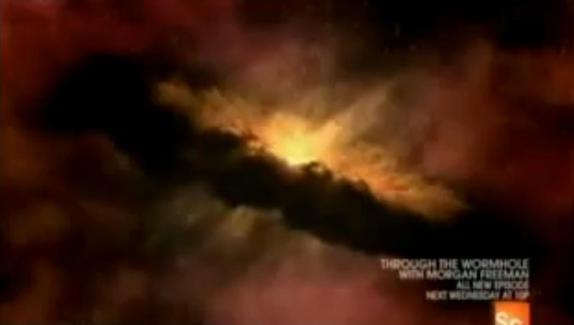 In this episode we meet several theoretical physicists, their theories of what a black hole is, and what they believe the effects black holes have on the space and objects that are caught in their gravitational pull. Professor Leonard Susskind said it best when he said “The black hole is the window into a world that we don’t have the mental architecture to envision properly.” Freeman tells us “the notion of a black hole is the natural extension of the laws of gravity. The closer you are to a massive object, the more the pull of its gravity slows down anything trying to escape from it.” He explains to us that if the earth were “squeezed” into mass as small as its center, then everything trying to escape would be caught in it’s gravity. This is the same as a black hole.
In this episode we meet several theoretical physicists, their theories of what a black hole is, and what they believe the effects black holes have on the space and objects that are caught in their gravitational pull. Professor Leonard Susskind said it best when he said “The black hole is the window into a world that we don’t have the mental architecture to envision properly.” Freeman tells us “the notion of a black hole is the natural extension of the laws of gravity. The closer you are to a massive object, the more the pull of its gravity slows down anything trying to escape from it.” He explains to us that if the earth were “squeezed” into mass as small as its center, then everything trying to escape would be caught in it’s gravity. This is the same as a black hole.
Freeman introduces the first theory from Professor Christian Ott. Professor Ott is a physicist at the California Institute of Technology. He is trying to find out if a collapsing star can produce a black hole. He compares a supernova to a marathon runner. “There is no heat generation, no more energy generation happening at its core so gravity keeps pulling in and there’s nothing producing pressure to sustain it. Without anything to sustain it, the star collapses.” The shockwave that it produces is a supernova. We had one explode in 1054 that was so bright it was visible during the day, and then again about 200 years ago. The dust and debris from these explosions are still visible to this day.
California Institute of Technology. He is trying to find out if a collapsing star can produce a black hole. He compares a supernova to a marathon runner. “There is no heat generation, no more energy generation happening at its core so gravity keeps pulling in and there’s nothing producing pressure to sustain it. Without anything to sustain it, the star collapses.” The shockwave that it produces is a supernova. We had one explode in 1054 that was so bright it was visible during the day, and then again about 200 years ago. The dust and debris from these explosions are still visible to this day.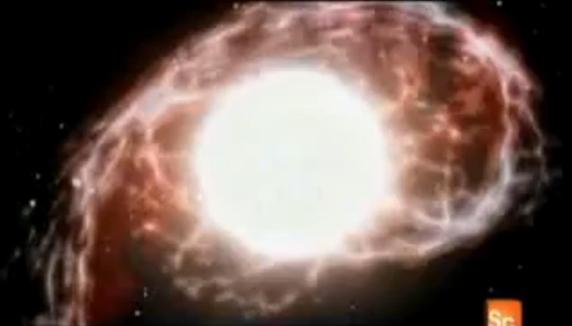 Freeman tells us that there are 2 ways to see if a supernova really produces a black hole. The first one is to witness a supernova in our own galaxy, and the other is to use a computer to see if it’s possible to produce a virtual black hole with a virtual supernova. Professor Ott explains that it’s difficult to use a computer to “simulate a black hole” because “it brings together a lot of physics; general relativity for gravity, and fluid dynamics for the gas that collapses, and its particle phsycis.” After years of calculations Professor Ott has a theory of how a black hole forms. He believes they form with an unnova or as Freeman states “it’s not a bang. It’s a whimper”. Ott believes that some stars simply disappear without a supernova explosion.
Freeman tells us that there are 2 ways to see if a supernova really produces a black hole. The first one is to witness a supernova in our own galaxy, and the other is to use a computer to see if it’s possible to produce a virtual black hole with a virtual supernova. Professor Ott explains that it’s difficult to use a computer to “simulate a black hole” because “it brings together a lot of physics; general relativity for gravity, and fluid dynamics for the gas that collapses, and its particle phsycis.” After years of calculations Professor Ott has a theory of how a black hole forms. He believes they form with an unnova or as Freeman states “it’s not a bang. It’s a whimper”. Ott believes that some stars simply disappear without a supernova explosion.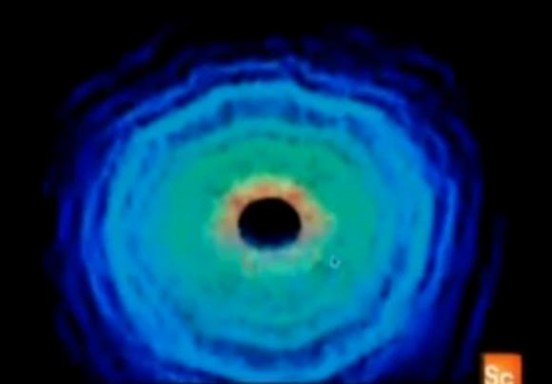 In 1931 Karl Jansky heard a background noise coming from the center of the Milky Way galaxy. It’s that
In 1931 Karl Jansky heard a background noise coming from the center of the Milky Way galaxy. It’s that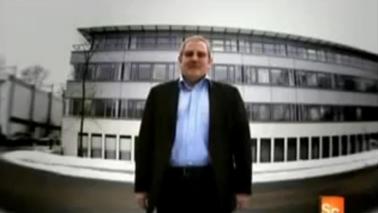 noise that Professor Reinhard Genzel believes came from a black hole. We can’t view the center of our galaxy because there is a thick dust cloud blocking our view. Due to its wavelength, infrared light can penetrate this dust. Genzel went to the Anaconda desert of Chile in 1992 to use infrared light to look at the center of our galaxy. Professor Genzel and his team mapped the large cluster of stars at our galactic center. They found that the stars were moving around a very massive object that was invisible. He then concluded that the noise that is coming from the center of our galaxy is coming from a massive black hole. In fact, scientists predict the black hole at the center of our galaxy is a supermassive black hole because it is 4 million times the mass of our sun.
noise that Professor Reinhard Genzel believes came from a black hole. We can’t view the center of our galaxy because there is a thick dust cloud blocking our view. Due to its wavelength, infrared light can penetrate this dust. Genzel went to the Anaconda desert of Chile in 1992 to use infrared light to look at the center of our galaxy. Professor Genzel and his team mapped the large cluster of stars at our galactic center. They found that the stars were moving around a very massive object that was invisible. He then concluded that the noise that is coming from the center of our galaxy is coming from a massive black hole. In fact, scientists predict the black hole at the center of our galaxy is a supermassive black hole because it is 4 million times the mass of our sun.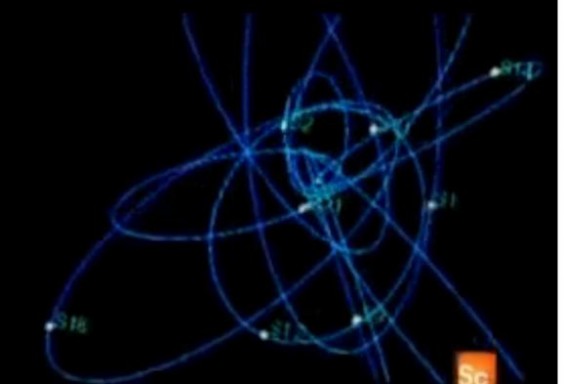 “Truth is stranger than sci-fi”. That is the next place Freeman takes us through the wormhole. Julie
“Truth is stranger than sci-fi”. That is the next place Freeman takes us through the wormhole. Julie Comerford is an astronomer and she has been studying the center of galaxies gathering information on the black holes. She studies the gas that falls into the black hole. As the gas falls into the black hole it lights up under the extreme temperatures. Julie found that some black holes had 2 different peaks. It would appear that they are waltzing. She calls this phenomenon the “black hole waltz”. Freeman said
Comerford is an astronomer and she has been studying the center of galaxies gathering information on the black holes. She studies the gas that falls into the black hole. As the gas falls into the black hole it lights up under the extreme temperatures. Julie found that some black holes had 2 different peaks. It would appear that they are waltzing. She calls this phenomenon the “black hole waltz”. Freeman said 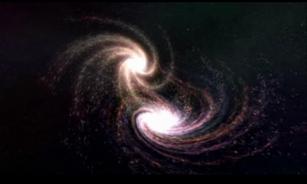 “black holes are paired up and dancing the cosmic night away.” Janna Levin is theoretical cosmologist that listens for black holes, and she believes you should be able to hear a pair of black holes as they dance around each other. Imagine space time is like fabric, and black holes warp this fabric. It’s this warping that theoretically should cause waves that can be heard. She demonstrates a computer simulation of a pair of black holes orbiting around each other and the noise that they make. The pattern that is formed looks a lot like the pattern that protons and electrons make as they orbit one another. How can two black holes that are massive behave like two subatomic particles? “This connection between the very big and the very small has already sparked a war between two of the greatest living physicists” explains Freeman.
“black holes are paired up and dancing the cosmic night away.” Janna Levin is theoretical cosmologist that listens for black holes, and she believes you should be able to hear a pair of black holes as they dance around each other. Imagine space time is like fabric, and black holes warp this fabric. It’s this warping that theoretically should cause waves that can be heard. She demonstrates a computer simulation of a pair of black holes orbiting around each other and the noise that they make. The pattern that is formed looks a lot like the pattern that protons and electrons make as they orbit one another. How can two black holes that are massive behave like two subatomic particles? “This connection between the very big and the very small has already sparked a war between two of the greatest living physicists” explains Freeman.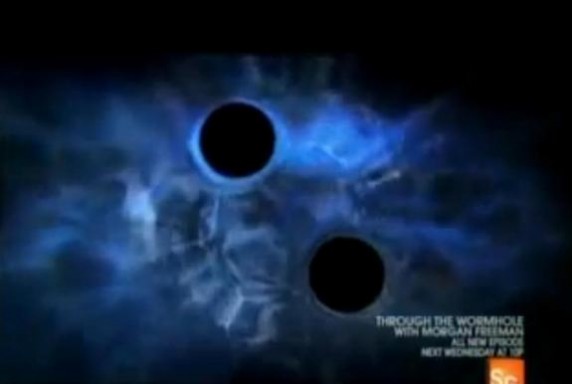 Einstein’s theory of relativity describes the very large made up of planets, stars, and galaxies. However, it does not describe the world of the very small. Quantum mechanics is the study of the very small.
Einstein’s theory of relativity describes the very large made up of planets, stars, and galaxies. However, it does not describe the world of the very small. Quantum mechanics is the study of the very small. 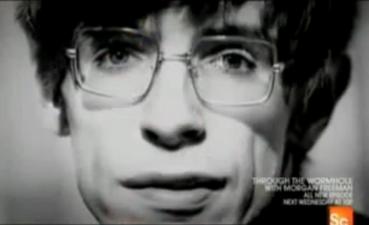 Professor Stephen Hawking believes that when virtual particles enter the event horizon of a black hole one escapes and the other falls into the black hole. The one that escapes is emitted as radiation. The radiation is also known as “Hawking radiation.” Seven years after his theory on Hawking radiation Professor Hawking stated that “for every ounce of material a black hole absorbed into it’s core it would radiate an equivalent amount of energy from it’s event horizon.” This became known as the “information paradox.”
Professor Stephen Hawking believes that when virtual particles enter the event horizon of a black hole one escapes and the other falls into the black hole. The one that escapes is emitted as radiation. The radiation is also known as “Hawking radiation.” Seven years after his theory on Hawking radiation Professor Hawking stated that “for every ounce of material a black hole absorbed into it’s core it would radiate an equivalent amount of energy from it’s event horizon.” This became known as the “information paradox.”
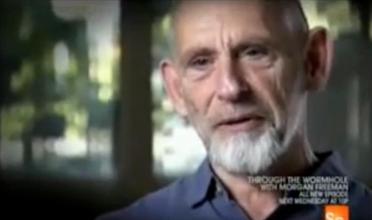 Leonard Susskind is a theoretical physicist that started as a plumber, and he disagrees with Hawking. Susskind said that Hawking’s theory “violates a very very fundamental principal of physics called conservation of information.” Hawking believed that the center of the black hole and the event horizon do not share any information. He also believes that information that falls into the black hole is lost forever. Hawking believed that black holes simply disappear and all the information and mass inside of a black hole also disappears. Susskind emphatically does not support this theory. This “War of black holes” waged on for 30 years.
Leonard Susskind is a theoretical physicist that started as a plumber, and he disagrees with Hawking. Susskind said that Hawking’s theory “violates a very very fundamental principal of physics called conservation of information.” Hawking believed that the center of the black hole and the event horizon do not share any information. He also believes that information that falls into the black hole is lost forever. Hawking believed that black holes simply disappear and all the information and mass inside of a black hole also disappears. Susskind emphatically does not support this theory. This “War of black holes” waged on for 30 years.
Susskind introduced us to two astronauts Bob, Alice and the “dead and alive paradox.” Because of Einstein’s theory of general relativity, the two astronauts have two separate views of the same event. From Bob’s point of view, Alice will drift closer to the black hole and once she reaches the event horizon she will appear to stay there. From Alice’s point of view she will fall through the event horizon without noticing anything different until she reaches the inside of the black hole. Alice would then die because inside a black hole is a very hostile environment. 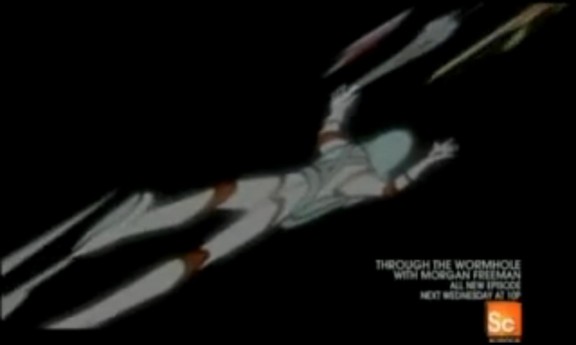 Susskind then explains the “holographic principal”. He applied string theory to what happens at the event horizon of a black hole. In string theory particles are vibrating at high speeds. This time he puts Alice in an airplane that has a propeller. He said a black hole is like a high speed camera. It can take pictures and smear them all over the even horizon. Alice would still continue to see the hub of her airplane, but Bob would see her smeared all over the event horizon.
Susskind then explains the “holographic principal”. He applied string theory to what happens at the event horizon of a black hole. In string theory particles are vibrating at high speeds. This time he puts Alice in an airplane that has a propeller. He said a black hole is like a high speed camera. It can take pictures and smear them all over the even horizon. Alice would still continue to see the hub of her airplane, but Bob would see her smeared all over the event horizon.
In both cases Alice meets a horrible death. However, Susskind solved the information paradox by showing that information that is radiated out as Hawking radiation is smeared on the event horizon forever, and is not lost as Hawking believed. Hawking conceded defeat at a conference in Dublin. Freeman does not go into detail with this but I will expand on it just a little. Hawking stated at this conference that for every universe that has a black hole there is a parallel universe without a black hole. Therefore, information is preserved in the universe without the black hole. This revelation of Hawking came after a lengthy hospital stay in which he almost conceded his life. Thankfully for us and all of physics Professor Hawking won his battle.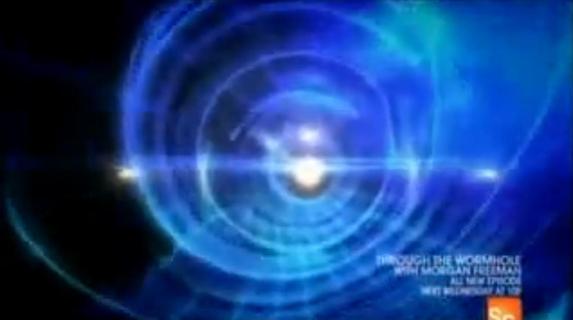 Susskind not only won the battle of the black holes, but he has forced us to change the way we look at everything in our universe. We see objects differently now. There’s a 3D version of us and a holographic image of everything. How these two different puzzles fit together is a new challenge to physicists.
Susskind not only won the battle of the black holes, but he has forced us to change the way we look at everything in our universe. We see objects differently now. There’s a 3D version of us and a holographic image of everything. How these two different puzzles fit together is a new challenge to physicists.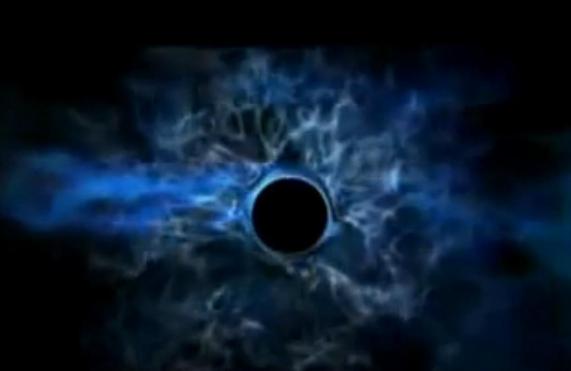 Freeman wraps up this episode of “Through the Wormhole by saying “black holes have been a source of fascination for almost a century. We’ve thought of them as time machines, shortcuts to parallel universes, and monsters that will one day devour the Earth.
Freeman wraps up this episode of “Through the Wormhole by saying “black holes have been a source of fascination for almost a century. We’ve thought of them as time machines, shortcuts to parallel universes, and monsters that will one day devour the Earth.
While any of these ideas may turn out to be true one day, right here right now black holes have a profound effect on you and me. Their shimmering holographic surfaces seem to be telling us that everything w e think is here is mirrored out there at the very edge of our mysterious universe.”
e think is here is mirrored out there at the very edge of our mysterious universe.”
Thank you all for reading. Please feel free to leave a comment here or visit me on Twitter by clicking my avatar image. Thank you.
RedOne68 (Sandra)







Thanks Michael! I am really enjoying this show.
very cosmic review on through the wormhole the riddle of the black hole infinity and beyond! well done Sandra great job enjoy it impressively
You are so welcome Kenn. I enjoy every minute of writing and researching it!
Hey Sandra,
Super report! Loved the video news embed you selected to compliment the analysis. I had seen this before and think it was perfect for “Through the Wormhole”! As for knowing everything, even Albert used some “tricks in his equation” to make it “work”. Thank you for the time and effort in your research.
Best Reagrds
Yes Daniel!! Precisely!! I love it though. It means we do NOT understand everything and I believe when we do understand black holes we will have a better understanding of the start of our universe. I have a real radical theory I will share with you on FB.
I do not see a problem with infinity in the equations. If a black hole consumes and never stops consuming then the amount of mass it can hold is infinite. I believe there’s a connection with the singularity before the big bang and the singularity at the heart of a black hole.
Thanks for your comment Daniel!
Beautiful article!!!
***
I use to back in time in order to understand how these theories works: on Cauchy, Karl Weierstrass, Bézout, Zariski, Penrose, Hassler Whitney, René Thom… the mathematical aspects refers to objects that are not defined.
Are jumps of infinite discontinuities, when the values does not exist, because are infinities.
so if we apply those canons to gravitational fields we got a “black hole”
Jorge Luis Borges use to say that: the devil of all theories is the Infinity, when Infinity come to scene all toughs begins to tremble